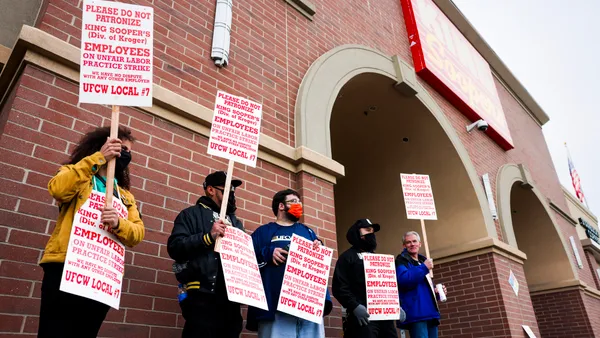Dive Brief:
- Southeastern Grocers has filed plans with the U.S Securities and Exchange Commission for an initial public offering, the latest step in its financial transformation since emerging from Chapter 11 bankruptcy in mid-2018.
- The grocery chain is looking to go public as it slims down its store fleet and tightens its focus on its Winn-Dixie banner, which will eventually account for 87% of Southeastern’s locations, according to the filing.
- Southeastern is preparing for an IPO at a time when grocery stores are riding a wave of customer interest during the pandemic. The grocer said it recorded net income of $205.7 million and $5.3 billion in sales during the 28-week period that ended July 28, compared with a net loss of $116.2 million and sales of $8,3 billion in fiscal 2019.
Dive Insight:
Southeastern’s decision to jump into the stock market reflects the company’s growing confidence as the supermarket industry continues to benefit from the changes in shopping habits that have taken hold since the pandemic began in March.
“We believe the impact of the COVID-19 global pandemic has enabled us to solidify our competitive positioning, enhance our value proposition and connect us more closely with our customers,” Southeastern said in its SEC filing, which it delivered to regulators on Monday. The company added that it has improved its cash flow, enabling it to invest more heavily in its stores, digital infrastructure, efforts to connect with customers and reduce debt.
Southeastern indicated that it planned to raise $100 million from the stock offering, though that figure could change as the company and its advisors evaluate market conditions in advance of the IPO. The retailer did not provide a price range for the offering.
The grocer said its sales have improved significantly during the pandemic, and indicated that it believes that its median comparable sales growth of 26% between March and July was above that of six of its competitors, whose median comprable sales ranged from 9% to 21%. But Southeastern also said that efforts it made in earlier years to expand its operations ultimately turned out poorly, forcing the company into a painful restructuring that included a bankruptcy reorganization and later set it on a path to selling a substantial chunk of its stores.
Southeastern’s expansion was driven by the 2012 merger between the former Bi-Lo and Winn-Dixie companies that led to the formation of the current company. It said in its filing that its store count rose 265% between 2011 and 2015, a period that included its acquisition of banners like Harveys and Sweetbay as well as an aborted bid to go public.
One result of Southeastern’s growth was that it strengthened its presence in the competitive Florida grocery sector, but the company acknowledged in its filing that it had trouble executing on its plans. “While we realized positive initial results from our expansion and have benefited from exposure to the attractive Florida market, the increased attention required to integrate these stores and implement a new supply agreement, as well as significant price investments, including a switch to an everyday low price strategy in 2016, hampered our financial performance,” the company said in the prospectus.
In May, two years after emerging from bankruptcy, Southeastern agreed to sell 62 Bi-Lo and Harveys stores to Food Lion and said it would retire the Bi-Lo banner. The grocer also struck deals with CVS and Walgreens to sell its prescription files to the pharmacy operators.
Southeastern announced in September that it would sell 23 Bi-Lo and Harvey’s locations to grocers Alex Lee and B&T Foods.
Southeastern’s divestment efforts this year will reduce its store fleet to 420 locations in Alabama, Florida, Georgia, Louisiana and Mississippi. Following the sales, 87% of the company’s remaining 420 stores will operate under the Winn-Dixie banner, which analysts have said is key to the company’s prospects going forward. The company has been investing in the Winn-Dixie brand, and is set to open eight new locations by early 2021.
Southeastern hopes changes to Winn-Dixie, including refreshed store designs and an updated private label assortment, will help it better compete against Publix and several other chains that are expanding in the Southeast. In past years, Publix in particular has been a roadblock to progress as it continues to make updates, including building out its GreenWise Market specialty store format.
The grocer’s stock offering is being led by Bank of America and Goldman Sachs. PJ Solomon, which has advised Southeastern on its store sales, is providing financial advice to the company as it prepares for the stock sale. The company will trade on the New York Stock Exchange under the ticker symbol SEGR.













